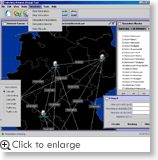Network Simulation
For the implementation of an economical telecommunications network the verification and validating of the results of the network planning are mandatory necessary. Analytic procedures can be consulted, however such procedures exist only for special circumstances and mostly require simplifications and approximations, that leads to negative effects on the results. These disadvantages can be prevented by the application of the simulation.
A simulation enables the analysis of systems on base to a reproduction of the systems and their characteristics in software. In this way the behavior of a system under different conditions can be observed, whereby the conditions and also the system must not be really exist. So planning faults can be localized and corrected, before the cost-intensive implementation of the network components begins. One prevents to bad investments by oversizing likewise, like a too small interpretation of the network capacities with high re-tooling costs resulting from it.
A second very important function of the network simulation is the reproduction of interesting network scenarios (e.g. high -, overload situations, link and node failures). Critical weak points can be detected and suitable measures for the increase of the network performance or network stability in such exceptional cases can be derived by the observation of the respective behavior of the telecommunications network.
Basically the simulation environment offers free-defined routing schemes. By the adaptation of the file interface for routing schemes and small modifications at the actual simulator routine, the use of any routing methods is possible. The SOC (Sequential Office Control) and OOC (Originating Office Control) are implemented at present and are available as default routing methods.
During the simulation is running different parameters of the network can be observed on-line:
- End-To-End blocking: averaged for the whole network, individual for each arranged pair of traffic
- link blocking for every link in the network
- link load for every link in the network
- node load for each node in the network
The simulator implemented here operates event-driven. That is, that the simulation time progresses not continuously but discretely. For this an event list is administered for all events occurring in the simulated network (e.g. arrivals of call, line de-energising, node or link failure, high load appearance, etc..) in the order of its appearance. These are then sequentially processed, while again resulting events are sorted according to their arrival time into the event list.
The behaviour of telephone subscriber can be derived from the distribution density functions, the mean holding time and the distance between call arrivals. Here both for the holding time and the arrival distance the negative exponential distributions are assumed (Poisson-Traffic).
For the determination of the processor load in a switching center (AXE) the technical data from manufacturer is used. Hereby the expenditure connected with an arrival of call can be observed intended for the processors involved as well as their extent of utilization.
The network simulation environment is implemented in Java using Swing as GUI.
